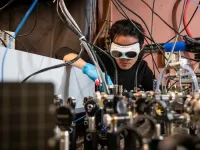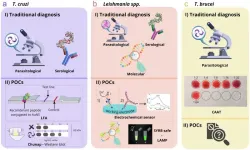(Press-News.org) Expert sommeliers can take a whiff of a glass of wine and tell you a lot about what’s in your pinot noir or cabernet sauvignon.
A team of physicists at CU Boulder and the National Institute of Standards and Technology (NIST) have achieved a similar feat of sensing, only for a much wider range of substances.
The group has developed a new laser-based device that can take any sample of gas and identify a huge variety of the molecules within it. It is sensitive enough to detect those molecules at minute concentrations all the way down to parts per trillion. Its design is also simple enough that researchers could employ the method quickly and at a low cost in a range of settings, from diagnosing illnesses in human patients to tracking greenhouse gas emissions from factories.
The study was led by scientists at JILA, a joint research institute between CU Boulder and NIST. The team will publish its findings on Feb. 19 in the journal Nature.
“Even today I still find it unbelievable that the most capable sensing tool can in fact be built with such simplicity, using only mature technical ingredients but tied together with a clever computation algorithm,” said Qizhong Liang, lead author of the research and a doctoral student at JILA.
To show what the tool is capable of, Liang and his colleagues drilled down on an important question in medicine: What’s in the air you breathe out?
The team analyzed breath samples from real human subjects and showed that they could, for example, identify the types of bacteria living in peoples’ mouths. The technique could one day help doctors diagnose lung cancer, diabetes, chronic obstructive pulmonary disease (COPD) and much more.
Physicist Jun Ye, senior author of the study, said the new work builds on nearly three decades of research into quantum physics at CU Boulder and NIST—especially around a type of specialized device known as a frequency comb laser.
“The Frequency comb laser was originally invented for optical atomic clocks, but very early on, we identified its powerful application for molecular sensing,” said Ye, a fellow of JILA and NIST and professor adjoint of physics at CU Boulder. “Still, it took us 20 years to mature this technique, finally allowing universal applicability for molecular sensing.”
A shaking cavity
To understand how the team’s technology works, it helps to understand that all gases, from pure carbon dioxide to your stinky breath after you eat garlic, carry a fingerprint of sorts.
If you probe those gases with a laser that spans multiple “optical frequencies,” or colors, the molecules in the gas samples will absorb that light at different frequencies. It’s almost like a burglar leaving behind a thumbprint at a crime scene. In a previous study, for example, Liang and his colleagues used this laser absorption detection principle to screen human breath samples for signs of SARS-CoV-2 infections.
Frequency combs are well suited to that technique because, unlike traditional lasers, they emit pulses of light in thousands to millions of colors at the same time. (JILA’s Jan Hall pioneered these lasers, winning the Nobel Prize in Physics for his work in 2005).
But to detect molecules at low concentrations, those lasers must also pass through the gas sample over distances of miles or more so that the molecules can absorb enough light.
To be practical, scientists must realize that distance within containers for gases that are measured on the scale of a foot.
“We enclose the gas sample with a pair of high-reflectivity mirrors, forming an ‘optical cavity,’” Liang said. “The comb light can now bounce between those mirrors several thousand times to effectively increase its absorption path length with the molecules.”
Or that’s the goal. In practice, optical cavities are tricky to work with and eject laser beams if they aren’t properly matched to the resonant modes of the cavity. As a result, scientists previously could only use a narrow range of comb light, and detect a narrow range of molecules, in a single test.
In the new study, Liang and his colleagues overcame this longstanding challenge. They presented a new technique they named Modulated Ringdown Comb Interferometry, or MRCI (pronounced “mercy”). Rather than keep its optical cavity steady, the team periodically changed its size. This jiggling, in turn, allowed the cavity to accept a much wider spectrum of light. The team then deciphered the complicated laser intensity patterns emerging from the cavity with computational algorithms to determine the samples’ chemical contents.
“We can now use mirrors with even larger reflectivity and send in comb light with even broader spectral coverage,” Liang said. “But this is just the beginning. Even better sensing performance can be established using MRCI.”
A sensor for breath
The team is now turning its new gas sniffer on human breath.
“Exhaled breath is one of the most challenging gas samples to be measured, but characterizing its molecular compositions is highly important for its powerful potential for medical diagnostics,” said Apoorva Bisht, co-author of the research and a doctoral student in Ye’s lab.
Bisht, Liang and Ye are now collaborating with researchers at CU Anschutz Medical Campus and Children’s Hospital Colorado to use MRCI to analyze a range of breath samples. They are examining whether MRCI can distinguish samples taken from children with pneumonia from those taken from children with asthma. The group is also analyzing the breath of lung cancer patients before and after tumor removal surgery and is exploring whether the technology can diagnose people in early stages of chronic obstructive pulmonary disease (COPD).
“It will be tremendously important to validate our approach on real world human subjects,” Ye said. “Through close collaboration with our medical colleagues at CU Anschutz, we are committed to developing the full potential of this technique for medical diagnosis.”
END
New sensor can take any gas and tell you what’s in it
2025-02-19
ELSE PRESS RELEASES FROM THIS DATE:
How the brain balances risk and reward in making decisions
2025-02-19
At a glance:
Study in mice offers insights into the brain circuitry underlying certain types of reward-based choices.
Researchers identified distinct groups of brain cells activated when animals anticipate a reward to be above average or below average for a choice.
The findings enhance understanding of human decision-making and how the brain balances risk and reward.
Every day, our brain makes thousands of decisions, big and small. Any of these decisions — from the least consequential such as picking ...
Jumbled proteins paint a bold target on the backs of brain tumors
2025-02-19
Immune therapy has transformed how cancer is treated, but many tumors continue to evade these treatments, thanks to their resemblance to healthy tissue.
Now, researchers at UC San Francisco have found that some cancers, like deadly brain cancer (glioma), make unique, jumbled proteins that make them stand out. These newly recognized cancer-specific proteins, or antigens, could speed the development of potent immunotherapies that recognize and attack hard-to-treat tumors.
The study, which was supported through grants from the National Institutes of Health, appears in Nature on ...
Liver injury in immune Stevens-Johnson Syndrome and toxic epidermal necrolysis: Five new classification types
2025-02-19
Introduction
First identified by Stevens and Johnson in 1922, SJS and TEN are now recognized as disorders with a continuum of severity, from milder forms (SJS) to the most severe (TEN). SJS/TEN is associated with multiple etiological factors, most notably drug-induced liver injury (DILI), making the identification of the responsible agent crucial for patient management. However, previous studies have lacked uniformity in diagnostic approaches, limiting the ability to draw clear conclusions about causality.
Epidemiology
The incidence of SJS/TEN varies across regions, with notable differences between studies. For instance, ...
MSU study: Socioeconomic factors, unpredictability complicate diagnosis of episodic disabilities, like epilepsy
2025-02-19
Any patient suffering from new or worsening medical symptoms hopes for a relatively quick and accurate diagnosis.
However, for many people with episodic disabilities — periodic or intermittent conditions like migraines, lupus, Crohn’s disease and epilepsy, in which the presence and severity of symptoms fluctuate — a swift diagnosis is not guaranteed.
New research from Michigan State University focuses on diagnostic delays experienced by people with one such condition: epilepsy, a neurological disorder characterized by unpredictable seizures that affects over 3 million people in the United States and 50 million worldwide.
“Epilepsy ...
Revolutionizing tropical disease treatment: The future of conjugating nanomaterials with drugs
2025-02-19
Introduction
Neglected Tropical Diseases (NTDs) remain a significant health burden in tropical and subtropical regions, with limited treatment options and diagnostic capabilities. These diseases are often neglected in research and policy, yet they contribute to high mortality and morbidity worldwide. Nanotechnology, particularly the conjugation of nanomaterials with drugs, presents an innovative approach to improving both the diagnosis and treatment of these diseases. Nanomaterials have unique properties that allow for enhanced drug delivery, ...
Improving quality of life and end-of-life care: Standardizing goals of care notes in EHRs
2025-02-19
INDIANAPOLIS – It is important that a healthcare team is aware of and understands a patient’s goals of care, both medical and personal. But that information, if documented, typically is not placed in a standardized location and is difficult to find within a patient’s voluminous electronic health record (EHR).
A new study by researchers from Regenstrief Institute, the Indiana University School of Medicine and Indiana University Health presents the standardized goals of care note they developed, deployed and evaluated as a quality improvement initiative at ...
Taking vitamin E during pregnancy may decrease peanut allergy in children
2025-02-19
New research found that supplementing maternal diet with α-tocopherol, a form of vitamin E, can reduce the development of food allergy and anaphylaxis in newborn mice.
The prevalence of food allergy in children increased 50% from 2007 to 2021 in the United States (US), with the incidence of peanut allergy tripling in that time. This new study, published in The Journal of Immunology, shows the potential for α-tocopherol in prenatal vitamins during pregnancy and lactation to address this alarming increase and reduce development of food allergy early in life.
The study found that ...
AI in retail: how to spark creativity and improve job satisfaction
2025-02-19
Artificial intelligence (AI) is reshaping workplaces by streamlining routine tasks and boosting efficiency, particularly in retail, where innovation is essential for maintaining a competitive edge. Beyond automation, AI supports employee creativity by offering valuable insights and allowing them to focus on innovative tasks. However, research is limited on how AI service quality impacts employees in retail industries, making this an important area to explore.
Researchers from Florida Atlantic University and Hanyang University in Seoul, South Korea, examined how perceived AI service quality influences retail employees’ ...
1 in 5 older adults get infections after heart surgery, and women have a 60% higher risk
2025-02-19
One in five older adults gets an infection up to six months after heart surgery — with women far more likely to develop one, according to studies led by Michigan Medicine.
The two studies examined thousands of cases involving Medicare beneficiaries who underwent coronary artery bypass grafting, also known as CABG or heart bypass, or aortic valve replacement.
Women had 60% greater odds of developing postoperative infections, the three most common being urinary tract, pneumonia and sepsis.
Black patients also had higher rates of overall infection (28%) ...
New funding to support food security, economic resiliency
2025-02-19
DALLAS, Feb. 19, 2025 — The conditions in which we are born, live, learn, work, play and age — the social drivers of health — are better predictors of health and life expectancy than our genetic code. In communities nationwide, people living in locations just a handful of miles apart can have a dramatic difference in life expectancy.
To help level the playing field, the Grubhub Community Fund awarded the American Heart Association® Social Impact Funds a $2 million grant to support food security, technology innovation and economic resiliency in New York City and Chicago.
“We are grateful ...


